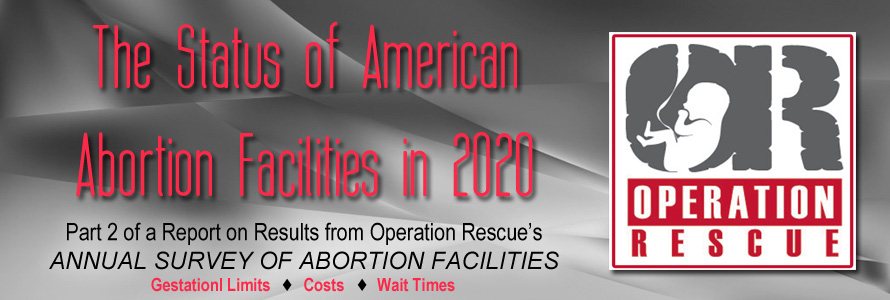
PART TWO OF A TWO-PART OPERATION RESCUE SPECIAL REPORT
By Cheryl Sullenger
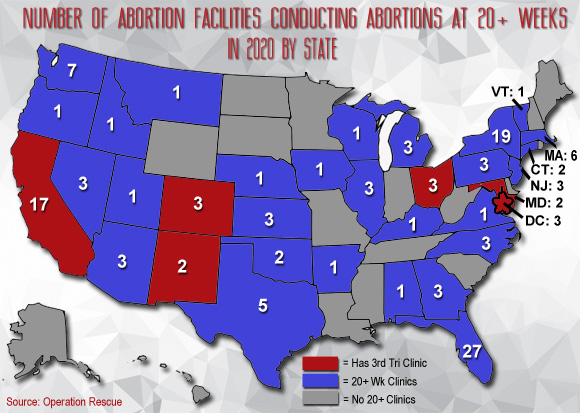
A new survey of abortion facilities in the U.S. has revealed that the number of surgical abortion facilities willing to do abortions past 13 weeks gestation continues to rise, while those that limit surgical abortions to 13 weeks or under decreased by a dramatic 27 percent. This shows that abortion businesses are continuing to add lucrative multi-day procedures that can reap large profits.
The survey also found the following:
- There are 706 abortion facilities in the U.S., comprised of 458 surgical and 248 abortion pill clinics — down four facilities overall since 2019.
- The percentage of surgical abortion facilities that self-impose abortion limits at 13 weeks or under dramatically dropped over the past two years from 46% in 2018 to just 19% in 2020. The category of abortion facilities that place gestational limits at 14-19 weeks grew the fastest in 2020, now comprising 51% of all abortion facilities.
- The number of abortion facilities willing to do abortions at 20 weeks gestation or later dropped slightly by one percent in 2020. Thirty percent of all abortion facilities now conduct abortions that late into pregnancies.
- The national average cost of a first-trimester abortion jumped to a new record high of $612 – up $9 from 2019.
- The national average wait time for abortion appointments rose to 8.4 days in 2020, primarily due to effects from the China Virus.
“The year 2020 was a year of changes within the Abortion Cartel as they grappled with new pro-life legislation and policies, and the impacts of the China Virus,” said Troy Newman, President of Operation Rescue. “We see women being exploited more than ever by rising prices for abortion drugs in facilities that have low overhead costs. We also see abortions becoming riskier with the continued push into the dangerous second trimester abortion market. This information exposes areas where more can be done to save lives.”
Methodology
Each year, Operation Rescue conducts a nationwide survey that involves contact with each abortion business in the U.S. The information gathered about the abortion clinics and their practices represents the most accurate data available.
This most recent data was compiled by Operation Rescue, which conducted a survey of all abortion facilities in the U.S. from November 18 through December 6, 2019.
Operation Rescue defines “abortion clinics” as those businesses that conduct abortions outside a hospital setting. There are two categories of abortion clinics:
- Surgical Abortion Clinics: These offices conduct surgical abortions. Almost always, surgical facilities also distribute abortion-inducing drugs.
- Abortion Pill Clinics: These offices supply abortions through the administration of drugs (pills) or other chemical means. They do not conduct surgical abortions.
Gestational Age Limits
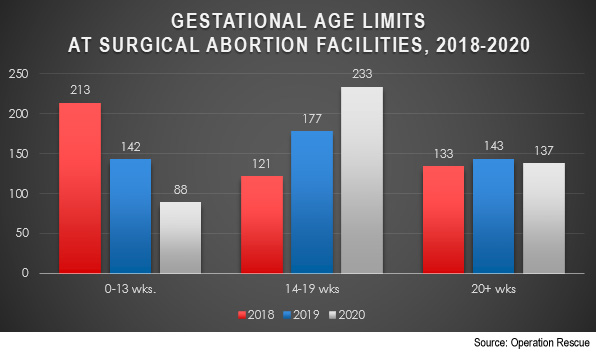
While most states set gestational limits for abortions, each abortion facility has its own self-imposed limit on how far into a pregnancy they are willing to conduct an abortion.
Because of the nature of abortion drugs, facilities that offer only that option limit abortions to 11 weeks or less. Planned Parenthood dominates in ownership of abortion pill clinics, operating 208 out of the 248 such clinics now open.
There has been a push to expand the distribution of abortion drugs using telemedicine. Sixty-nine facilities now operate telemedicine abortion programs. (More about that in Part 1 of this report.)
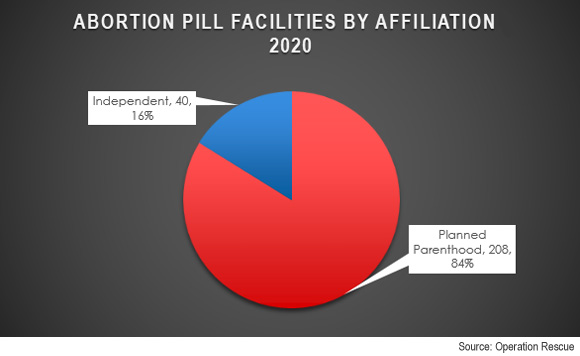
In 2018, 46 percent of all surgical abortion facilities set a gestational limit of 13 weeks or under. However, in 2020, only 19 percent of all surgical abortion facilities restricted themselves to the first trimester of pregnancy.
Surgical abortion clinics that set self-imposed abortion limits between 14-19 weeks gestation now comprise 51 percent of all surgical abortion facilities.
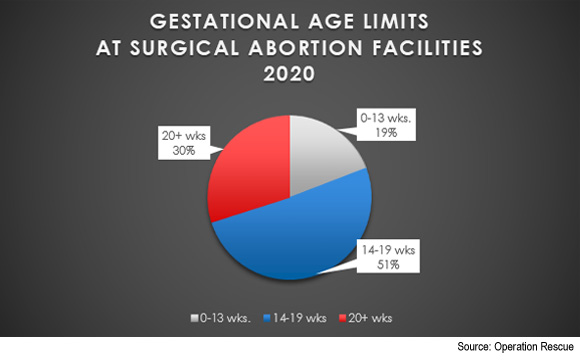
Rise in surgical abortion facilities willing to push beyond the first trimester is partially due to the China Virus.
Eleven surgical facilities volunteered that they had altered how abortions were done, citing the China Virus and desire to limit personal contact. Others many have also altered operations, but did not volunteer that information to researchers.
- At four facilities, abortions were only available using abortion drugs until the twelfth week of pregnancy. After that, surgical abortions were available into the second trimester.
- One facility halted surgical abortions altogether, but continued offering abortion drugs through 11 weeks of pregnancy.
- One facility halted all second trimester abortions, but continued surgical abortions throughout the first trimester.
- Three surgical facilities halted all abortions.
- Another facility halted abortions only because it had no one to do them due the virus.
- One surgical facility that did not offer abortion drugs bucked the trend and continued first trimester surgical abortions while temporarily suspending all second trimester abortions due to the pandemic
Currently, there are 137 surgical abortion facilities that will conduct abortions at 20 weeks or more, down slightly (1%) from 2019. This category accounts for 30 percent of all abortion facilities.
Independent abortion businesses still account for the vast majority of facilities willing to abort at 20 weeks or later. Of the 137 facilities that conduct the later abortions, 106 are independently operated facilities, while 31 are affiliated with Planned Parenthood.
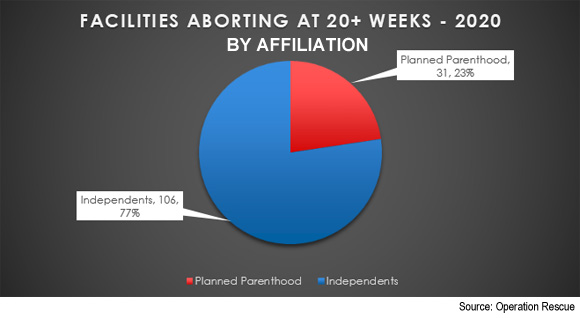
Abortion facilities that offer abortions throughout all stages of pregnancy are open about having no gestational limits. Others may state limits under the third trimester of pregnancy even though they actually will conduct them much later. Abortion facilities with “fetal indications” programs or conduct abortions for other so-called “medical” reasons, have essentially stripped away all stated gestational limits.
Eight abortion facilities openly abort throughout all nine months. Those include:
- Boulder Abortion Clinic in Boulder, Colorado.
- Stated limit: 30 weeks. (No longer does first trimester abortions.) Owner: Warren Hern.
- Capital Women’s Services in Washington, D.C.
- Stated limit: 36 weeks. Stake Holder: Steven Chase Brigham.
- CARE (Formerly AbortionClinics.org) in Bethesda, Maryland.
- Stated limit: 35 weeks. Owner: LeRoy Carhart.
- Southwestern Women’s Options in Albuquerque, New Mexico.
- Stated limit: 32 weeks. Owner: Curtis Boyd.
- Washington Surgi-Clinic
- Stated limit: 27 weeks. Owner: Cesare Santangelo.
- Women’s Med Center in Dayton, Ohio.
- Stated limit: Under 22 weeks. Owner: Martin Haskell.
- DuPont Clinic, Washington, D.C.
- Stated limit: Under 32 weeks. Operators: Matthew Reaves, Stacey Rubin, and Jessica Kuperstock.
- Pro-Choice Center in Beverly Hills, California.
- Stated limit: 24 weeks. Owner: Josepha Seletz.
The Pro-Choice Medical Center in Beverly Hills, California, limited abortions to under 11 weeks for a portion of 2020 due to the China Virus, but has since resumed late-term abortions on a “limited availability” basis.
First Trimester Abortion Costs

According to the Centers for Disease Control, in 2018, the most recent year with data available, 92.2% of all abortions take place in the first trimester of pregnancy, at or below 13 weeks gestation. Operation Rescue has tracked the cost of first trimester abortions for the past six years because it is most representative of what the average woman would commonly pay.
The national average cost of a first trimester abortion in 2020 increased nine dollars to $612.
The average cost of a first trimester abortion has steadily risen since 2015, when the national average cost was $577 — $35 less than 2020.
The cost of an abortion varied by type of abortion and by type of facility.
- The average cost of a surgical abortion was $621, up just one dollar over the previous year.
- Abortion drugs obtained at surgical abortion facilities nationwide averaged $598 – an increase of $14 over 2019 prices.
- Abortion drugs obtained at abortion pill clinics were the most expensive option at $622. This category had the largest price hike – up $18 over the previous year.
The fact that abortion drugs obtained at non-surgical abortion facilities are more expensive than the same drugs dispensed by a surgical abortion facility is an interesting one, especially since it is less expensive to operate an abortion pill clinic. That is because they do not have to be equipped to conduct surgeries and need no surgically trained staff that might require higher salaries.
Billing Trend
This year’s survey also detected an interesting occurrence not observed in previous years.
There are 26 California abortion facilities operated by Planned Parenthood Mar Monte and Planned Parenthood Northern California that are charging an astounding $2009.00 for abortion drugs. Planned Parenthood Mar Monte also operates an abortion facility in Reno, Nevada, that is charging $1,730.00 for abortion drugs.
In contrast, there are seven independent abortion facilities nationwide that charge between $1,000-$2,000 for abortion drugs, but even at that, all were less expensive than the $2,009 price tag at the California Planned Parenthood facilities.
The same Planned Parenthood facilities also charged $1,508.00 for surgical abortions – a whopping $896 above the national average.
There is an explanation for this. One Planned Parenthood worker told Operation Rescue’s researcher that while they will take cash for abortions, they preferred to use the client’s insurance.
Planned Parenthood uses a sliding scale based on income when charging women for abortions. Insurance reimbursements are billed to make up the difference. In California, Medi-Cal is a government-run program that provides free or low-cost health insurance. It has paid for abortions for low-income women and minors for decades.
That may explain why the 26 California Planned Parenthood abortion facilities are price-gouging.
“Could it be that these Planned Parenthood affiliates are bilking the taxpayers by over-billing tax-funded programs and other insurance companies?” asked Newman. “Why else would they aggressively encourage women to use insurance rather than cash, when abortion has traditionally been predominately a cash business? It is suspicious, to say the least.”
Given Planned Parenthood’s exorbitant abortion pill prices, it is not surprising that California posted the highest average cost for abortion drugs at a blistering price of $921.00.
Highest and Lowest
The state with the lowest average price for abortion drugs was Maryland at $423.00 – 54 percent lower that California’s average cost!
Hawaii had the highest average cost for surgical abortions at $880.00, while North Carolina weighed in as the least expensive state for surgical abortions with an average price of $417.00.


Wait times for appointments
It is not unusual to hear news reports about how women must wait weeks to get an abortion appointment due to the passage of pro-life laws.
This is just not true.
The national average time a woman must wait for an abortion is currently 8.4 days. This time is measured from the day a woman picks up the phone to make an appointment to the day of her actual abortion procedure. It includes a first appointment and state-mandated reflection times of 24-72 hours.
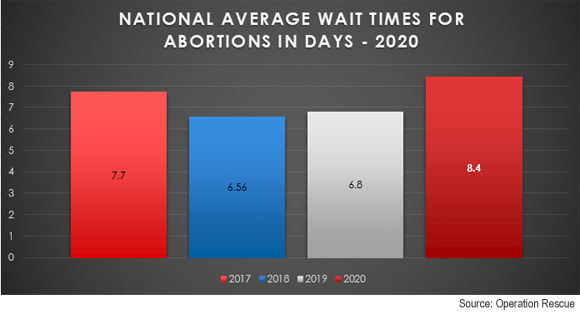
While waiting times for other medical office visits in 2020 were not available for a direct comparison, a 2017 report noted that nationally, it takes an average of 24 days to get an appointment with a family physician, between 12 and 51 days to get an appointment with an obstetrician, and 32.2 days to get an appointment with a dermatologist.
The average wait time for an abortion in 2020 represents an increase of 1.6 days nationally from 2019. This was due more to China Virus impacts than state laws, which changed very little in 2020.
For example, in California, it is possible for women to walk in to an abortion facility for the first time and get an abortion on the spot. But even without state reflection periods, women in California waited six days on average for a surgical abortion appointment and five days for abortion drugs in 2020.
“Because we obtained data from every abortion facility in the U.S., we know that this is the most accurate data out there on actual abortion wait times,” said Newman. “News reports that say women have to wait weeks for abortion appointments are nothing but fake news that is meant to manipulate public opinion against pro-life laws.”
Conclusions
Late-term abortions
Surgical abortion facilities that once only offered abortions through 13 weeks gestation moved dramatically into the 14-19 week abortion market in 2020. The number of facilities limiting surgical abortions to the first trimester has dropped 27 percent over the past two years.
This was partially due to an increase in abortion drug use as a replacement for surgical abortions in the first trimester due to China Virus considerations.
Since second and third trimester abortions risks to women increase with every passing week of pregnancy, the move into second trimester abortions increased dangers to women in 2020.
Until a complete ban on all abortions can be accomplished, Operation Rescue supports gestational limits on abortions.
Profit-taking
The average abortion cost is reflective of what a woman would pay out of her pocket. However, many clinics operate on a sliding scale or can bill insurance to cover part of the costs. In some states, abortion businesses also receive subsidies from state governments, along with reimbursements from private abortion funds. This allows abortion clinics to raise prices and profits, while not driving away customers.
That trend became more pronounced in 2020 as over two dozen California Planned Parenthood surgical facilities dramatically increased what they charged for abortions, then pressured clients to allow them to bill their insurance.
It is possible that the Trump Administration’s Protest Life Rule, which stopped Federal family planning grants from going to abortion businesses, may have contributed to this limited trend.
Some abortion facilities were affected by China Virus impacts, and that contributed to extended wait times in some areas.
Rush to close the deal
While the national average wait time for abortions increased in 2020, state laws had little impact. Getting an abortion became a bit more complicated with the China Virus shut-downs and other restrictions, especially in Democrat-run states. It is apparent from data collected during the survey that the abortion facilities’ own China Virus policies had more impact on the wait times than any state laws.
Even with the higher wait time, it is more in keeping with the average time a person must wait to get an appointment with a dentist, and much lower than it takes for a pregnant woman to get a first-time appointment with an obstetrician for routine pregnancy care.
Facing a Tenuous Future
It is a cold reality that political policy affects abortion facilities and how they do business.
With Democrats now in control of both houses of Congress and the Executive branch, we can expect greater challenges than ever as politically powerful pro-abortion factions press for liberalization and expansion of abortion with little to hold them back.
While abortion businesses celebrate their change in fortunes, the pro-life movement faces a tenuous future. Even our freedoms of speech and assembly that protect our ability to advocate for the unborn face erosion in this new political environment.
Yet, despite the political changes, we still have reason to hope.
Since the high water mark in 1991, when there were 2,176 abortion facilities in America, the business of abortion has been in dramatic decline. Powerful political allies, tax funding of abortions, and aggressive abortion training programs have been unable to stop that trend.
That is because the things that keep the evil of abortion in check are the prayers and outreach of pro-life supporters in every facet of life. We win when we bend our knees in prayer for an end to abortion, then act in faith on our convictions.
“As a dear friend of mine often said, ‘The victory is in obedience. The results are up to God,'” said Newman. “Even though our fight may become more difficult in the coming years, as long as we never give up, we will continue to see positive results until the day God mercifully opens the door to finally end abortion once and for all.”




